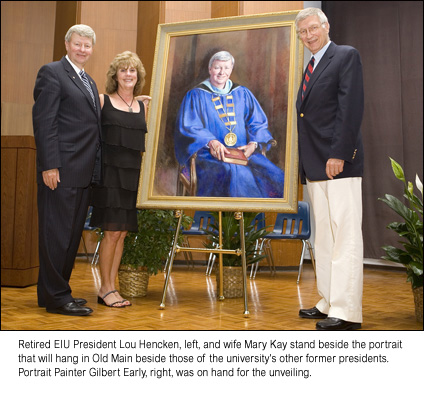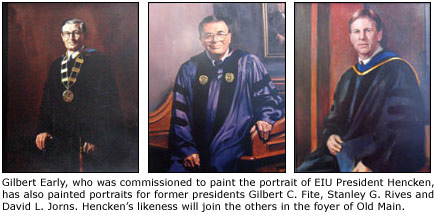Hencken's Portrait To Soon Join Those of His "Role Models"
Jul-02-2007  Louis V. Hencken often stopped in the foyer of Old Main - Eastern Illinois University 's administration building - to look upon the portraits of the presidents who preceded him.
Louis V. Hencken often stopped in the foyer of Old Main - Eastern Illinois University 's administration building - to look upon the portraits of the presidents who preceded him.
"I would think to myself, I hope that you all are pleased with the job that I'm doing,'" he said. "Those folks are all role models for me, and I didn't want to disappoint them."
Soon Hencken's likeness will take its rightful place among the others.
The portrait, unveiled over the weekend, will share a wall with the images of Daniel E. Marvin and David L. Jorns, Eastern's fifth and seventh sitting presidents, respectively. Directly across the hall hang portraits of Stanley G. Rives, Gilbert C. Fite and Carol D. Surles. The paintings of Livingston C. Lord (Eastern's first sitting president), Robert G. Buzzard and Quincy V. Doudna face northward, looking out upon the building's front lawn.
Three of those former presidents have something extra in common with Hencken. They, too, chose portrait painter Gilbert Early to commit their likenesses to canvas.
Hencken said he chose Early to paint his portrait because he had long admired Early's work on the portraits of Fite, Rives and Jorns.
"I thought they were very well done," Hencken said. "Early is an outstanding artist. I thought that he captured their personalities."
Early, in turn, expressed his own pleasure at being commissioned to paint his fourth EIU president. "I'm just extremely pleased that Mr. Hencken and the university like my work," he said.
 Early's subjects each had their own ideas about how they wanted to be seen in their portraits. Each is portrayed in an academic gown. Jorns is shown casually perched on the side of a desk, as is Rives. Those more familiar with Eastern's history will recognize Rives' desk as that once used by Livingston C. Lord, whose own portrait - in miniature - is reproduced in the background.
Early's subjects each had their own ideas about how they wanted to be seen in their portraits. Each is portrayed in an academic gown. Jorns is shown casually perched on the side of a desk, as is Rives. Those more familiar with Eastern's history will recognize Rives' desk as that once used by Livingston C. Lord, whose own portrait - in miniature - is reproduced in the background.
Hencken, too, is shown seated, although in a chair rather than on the side of a desk. A book lies closed upon his lap. Around his neck hangs the presidential medallion which, in addition to the university's seal and some colored stones, displays the names of Hencken and each of his predecessors.
Fite, too, wears the medallion in his portrait.
Early recalled the medallion, with all its detail, being "probably the most difficult part" of any of the EIU portraits he's done.
Capturing each president's personality, he added, came about as part of "the process."
He begins, Early said, by setting up a time to get to know his subject. In Hencken's case, the St. Louis-based artist drove to Charleston earlier this year and had lunch with the retiring president. Later that afternoon, the two men spent several hours together as Early took photographs in Hencken's office.
A preliminary sketch was made from those photos, and Hencken and his wife, Mary Kay, visited Early at his studio to review the early work.
"They were very involved," Early said, "and liked it in general. There was some question early on about eye color, and we got that taken care of."
Early, who began his career as a commercial artist in New York after graduating from Washington University Art School, evolved into a portrait painter by accident.
"There was a gallery in the building where I worked that specialized in portraits. I walked by it everyday, and got to know some of the artists who were successful at it," he said. When circumstance and dissatisfaction with commercial art intervened, Early tried his luck at it.
"Portrait painting is a little bit of a stepchild in the art world. I'm not sure why. I've always liked it, and I found a way to do them that seems to work."
It took a long time to build his business, as he "never really advertised." Early returned to St. Louis and took a teaching job, making calls in his spare time, slowly building up clientele for his portrait work. "It took seven years of teaching before building up enough commissions to live on," he recalled.
Now, at age 70, Early estimates his portraits number "well into the hundreds," although he can't give an exact count.
"It takes the better part of a month to do an entire portrait," he said, "and I usually have several going at a time," allowing him the opportunity to walk away from one and then come back to it "with a fresh eye."
He has no desire to retire. "I'm happy as long as I like the work," he said.
Others like his work, as well. In addition to the four Eastern Illinois University presidents, Early has painted portraits of three Missouri governors and their wives, nine Missouri Supreme Court judges, eight federal judges, several Fortune 500 chief executives and many children.
Early claims not to have a favorite among the many portraits he's done, although he will say that each has its own story. For example, he was just finishing his portrait of Missouri Gov. Melvin Eugene "Mel" Carnahan when the governor died in a plane crash while campaigning for the U.S. Senate (October 2000).
"That was a sad time," Early said. "I'd gotten to know both him and his wife."
Now Carnahan's portrait, along with that of his wife, is displayed in the Missouri State Capitol in Jefferson City.
Forty of Early's portraits can be viewed at his Web site: https://www.early17.com .
See here for related story.